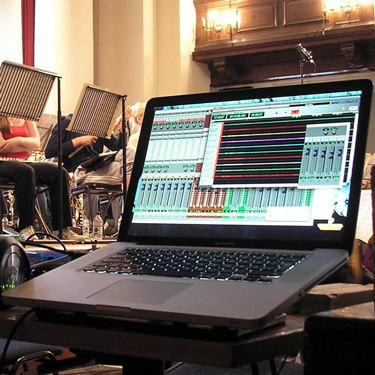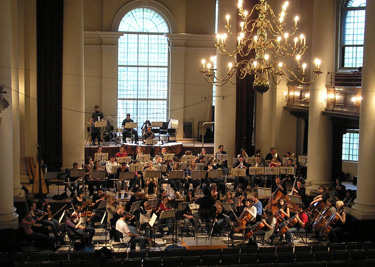|
 MIO Console and the Record Panel MIO Console and the Record Panel
LONDON, UNITED KINGDOM: Under the banner, “Outstanding Music for Outstanding Causes,” and the leadership of Michael Alexander Young, the Charities Philharmonia gets together twice a year to deliver creative and energetic concerts. All proceeds from the events go to benefit worthwhile causes and organizations. In recent years, Andrew Levine has had the opportunity to record the concerts, which almost always take place at St. John’s, Smith Square, in central London, a building erected in 1728 in the English Baroque-style. Its acoustics are stunning, and Levine has captured impressive stereo and surround recordings with minimal setup times using a Metric Halo ULN-8 mic-pre & interface with a Metric Halo MIO virtual mixer. The most recent recording took place at the end of May, with the ensemble performing Rachmaninov’s Isle of the Dead and Mahler’s Symphony No. 5.
Levine specializes in high-quality remote recordings using a mobile, environmentally-friendly (bike or public transportation) studio with a home-base in Hamburg, Germany. He also runs Blumlein Records, which brings exquisitely performed and recorded works of classical music to the world. Levine maintains a small cache of cables and microphone stands in London so as to minimize the luggage that he has to travel with when he records events in that city. For the most recent Charities Philharmonia, he needed only to bring a laptop, microphones, the Metric Halo ULN-8 interface, and a few other odds and ends.
"I always travel the day before big recordings,” said Levine. “In this case I arrived in London on Friday afternoon, allowing me to inspect all the gear and configure the MIO-Console in the evening. The setup began on Saturday at 11:00am, three hours before the rehearsal." The MIO-Console is the virtual mixer provided by the Metric Halo ULN-8 interface. Because the musicians’ chairs were not yet in place, Levine focused initially on the principle stereo and surround imaging, which required both stand-mounted mics behind the conductor and flown outriggers. He positioned the outriggers with cleverly-strung fishing line.
The main microphones were an AB-pair of Earthworks QTC-50s. DPA 4060s served as ambient outriggers in the tier above the audience. “It turned out that imaging on the 4060s was too direct, possibly because of reflections from the close walls,” said Levine. “During a break, I moved them higher up above a lateral passage to capture more of the sound of the hall itself.” To capture the violins and cellos, a pair of Royer Labs SF-1 ribbons flanked the conductor, facing sideways and angled 30- to 40-degrees downward. A United Minorities UM-1 in figure-8 configuration captured the woodwinds, and an Elation KM-201 with an omni-directional capsule provided the lead bass with a small boost. Multichannel location recording specialist Andrew Levine used Metric Halo's ULN-8 and MIO virtual mixer for the recent Charities Philharmonia concert Multichannel location recording specialist Andrew Levine used Metric Halo's ULN-8 and MIO virtual mixer for the recent Charities Philharmonia concert
“The Metric Halo ULN-8 has been a godsend for my mobile recording operations,” enthused Levine. “The mic pres and converters sound amazing and deliver the highest-quality live recordings with any mics – including the Royer ribbons, which require a huge amount of quiet gain. Also, having reliable mic pres and converters in one box leaves less to go wrong in what are already very stressful situations.”
The ULN-8 also boasts Metric Halo’s 2d on-board DSP, which provides both processing and mixing via a MIO-Console. “The MIO-Console is fast and intuitive to set up,” said Levine. “I track in stereo and surround – and in many cases both simultaneously – and I can configure a new mixer from scratch or modify one of my templates to meet the needs of any live recording situation.” For Charities Philharmonia, Levine used sample-accurate delays to bring the spot mics in phase with the main pickups, which significantly tightened up the sound and articulation of the entire mix. He also used some of the modeled “characters” that are available with the Metric Halo 2d DSP, putting a “valve” sound on the ambient mics and a “transformer” sound on the mixed sum. A final brick-wall limiter prevented any unexpected peaks from distorting. Levine captured the recording with 88.2 kHz, 24-bit fidelity.
The concert went off with only the sorts of minor glitches that will make any remote recording engineer flash a wry smile. “During the Rachmaninov piece, I detected a faint buzz in one of the ambient mics,” Levine recalled. “During a subsequent break, I investigated and found that someone had opened a door where a heating system is housed. I also found a videographer right next to the mic as well! He was accommodating and moved farther away for subsequent takes.” Otherwise, the recording is a fabulous testament to the talent of the ensemble, the acoustics of St. John’s, and the technical perfection of such a wonderfully-portable recording system. |